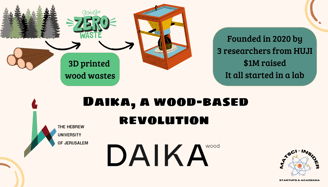
Daika, a wood-based revolution?
INTERVIEWSTARTUPBIOBASED


Turning wastes into valuable products does not only benefit the planet, it also makes plenty of sense economically, and Daika is doing just that. The Israeli startup is turning wood wastes into a super strong material that you can mould or 3D print to any shape you want, and ambitions to replace petroleum based materials in the near future. Michael Layani, co-founder and CEO, explains to us the steps he took to get Daika from purely academic research to a successful startup. The company is at an early stage, sure, but the market for sustainable materials is still looking for its champion, and the race is only getting started!
What is Daika?
Daika is an Israeli Startup founded in 2020 by 3 researchers from the University of Jerusalem. It has developed a new material based off wood wastes and without plastics or any petroleum based component. The particular chemistry they use, based notably on nanocellulose, allows the material to flow at relatively low temperature, which allows the use of mass manufacturing processes such as compression moulding or 3D printing. Once shaped, the product hardens and retains similar properties to wood in terms of strength, with the added value of being more resistant to water and the ability to retard fire. This way allows them to have the best of both world: they can shape their product on demand and almost without design limitations like plastic, while retaining the properties of natural wood. The end goal here is not to replace plastic globally, but to offer a sustainable and affordable alternative for very specific applications.
From the lab to the market
Daika originates from Yissum, the Tech Transfer company of the Hebrew University of Jerusalem, which aims to “Create commercial opportunities from breakthrough academic research”. It acts as a bridge between Science and Industry either by creating collaborations between industrials and scientists or by taking existing tech and IPs and turning them into companies. A paper was published in 2019 (Additive Manufacturing of 3D Structures Composed of Wood Materials), in which the team created a 3D printable material from wood products, paving the way to their current solution.
“We're here to solve two main challenges. The first is the wood waste problem and the second is the existing oil-based material. Daika is aiming to solve these two challenges in one shot by creating a new raw material by upcycling the waste streams and utilizing only natural ingredients that allow using existing manufacturing processes, such as extrusion and moulding to develop and manufacture products, which are 100% natural.” Dr. M. Layani, Cofounder and CEO
“We had in mind just an academic project, as always, but after we held the samples in our hand, we felt that there's something here, which is far beyond an academic paper.”
This scientific publication then led to a patent, and was taken out of the lab and onto the market by 3 researchers of the team. Dr. Layani, is the only one who completely put his academic career on hold to focus on Daika, and he explains the shift in paradigm between academic research and startup R&D:
“When you start off an academic project, it's all about innovation. It's all about seeing what people have done before you and trying to innovate. And we saw that nobody 3D printed something that was 100% natural. But once we took it to the industry, there had to be a solid business model. And this is why we pivoted from 3D printing to mass manufacturing processes.”
Today, 90% of Daika’s activity relies on extrusion and moulding rather than 3D printing. This illustrates the main challenge when going from Academia to industry: In academia, the research is all about the basic science, what is the theory behind it, underlying concepts etc. Whereas in industry, the focus is on the process, how is the product manufactured, is it economically viable and does the product fit in the market. This shift is hard to make for many innovations that work great in labs but fail in real-world applications.
A wood-based ink for 3D printers?
Daika’s solution utilizes wood wastes from sawmills that are usually burned. Governments used to fund this practice, but subsidies for such a solution are now halting, leaving sawmills with tons of waste to get rid of. Other alternatives do exist, but are not scalable and only apply to specific types of wood. In the research conducted at HUJI, they mixed the wood wastes with natural elements to form a material that can easily flow and hardens fast enough to be 3D printed. From this first application, Daika now offers a generic solution, based on existing industrial mass-manufacturing processes, hence that can be easily scaled up.
“This is where our capabilities as scientists helped us to pivot very easily. We understood that the chemistry that allows extrusion or allows 3D printing, will also allow the material to be utilized in mass manufacturing processes. [...] Today, 80 to 90% of the company is focused on extrusion and moulding.”
This innovation retains the basic properties of wood, but offers more flexibility in terms of design and processing. Their material is mainly used for consumer products and indoor design, but eventually, Daika will expand to other markets such as consumer electronics and toys.
Daika’s two cents
From an innovation made in academia to a successful startup, Dr. Layani and Daika are a perfect example of how to get materials science out of the lab and on the market. They were able to adapt their innovation to fit the reality of the market they were targeting and built on their scientific background to find solutions. We can learn from their story that getting out of the lab requires a clear understanding of the market, an innovation is only as useful as the need it fulfils, and it requires even more research and development to fit in this market. The shift Daika made from 3D printing to mass manufacturing processes is a clear illustration of that. Instead of getting their innovation straight out of the lab, they kept the chemistry and adapted the implementation to match the processes currently used in industry. This allowed them to easily slide in the market and offer their product as a viable alternative for today instead of a hypothetical innovation for tomorrow.
